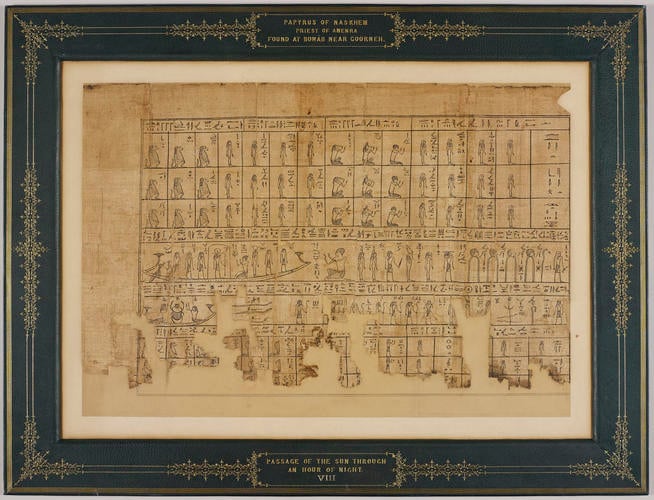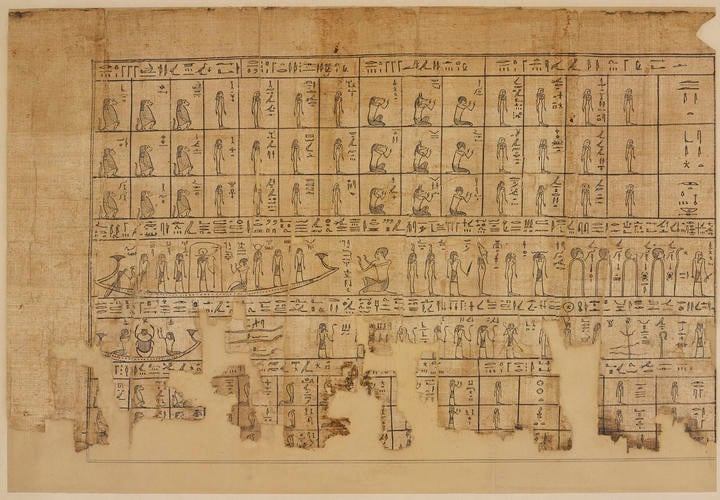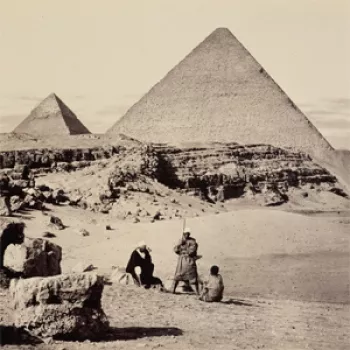Section of the papyrus belonging to Nesmin, with the first hour of the Amduat c.300-275 BC
61.5 x 80.5 cm (mount) (whole object) | RCIN 1145266
-
Section of the papyrus belonging to ‘God’s Father and Prophet of Amun-Ra, King of the Gods, Nesmin, born of the Lady of the House, Sistrum-player of Amun-Ra, Tasherit(en-ta)ihet’ with the first hour of the Amduat (see also RCINs 1145259-66)
The Amduat (literally ‘that which is in the netherworld’), also known as the Book of the Hidden Chamber, is a funerary text that describes the journey of regeneration of Ra, the Egyptian sun god, through the 12 hours of the night from sunset (symbolising death) to sunrise (symbolising rebirth). The text starts appearing in royal tombs from around 1500 BC, and the two most notable examples are perhaps those painted on the walls of the burial chambers of Thutmose III (1479–1425 BC) and Amenhotep II (1427–1400 BC) in the Valley of the Kings, Thebes. It represents an important stepping stone in the literary tradition of ancient Egypt, being the model for later Books of the Afterlife, and it maintains its relevance well into the Graeco-Roman era.
The main aim of the text is to offer a description of the netherworld so that the deceased, as well as the living, are able to gain familiarity with what to expect when their journey into the afterlife begins. Knowledge of the secret paths of the netherworld offers protection to the deceased from the dangers and threats he/she may encounter; the text shows the obstacles and demons that could obstruct a safe passage through the hereafter as well as the deities and beings able to assist and help the deceased towards the completion of the journey of regeneration.
The first hour of the Amduat, divided in three main registers, presents various important and typical beings of the netherworld. The clear symmetrical structure, in particular in the upper and lower registers, with groups of nine gods alternating with groups of twelve goddesses, can be read as a symbolic representation of order which is always to be maintained in the mind of ancient Egyptians. The forces of chaos and evil, in fact, represented by the snake-shaped Apophis, the most terrifying demon of the netherworld, is the main enemy which Ra encounters during his journey.
One of the key elements of the first hour of the Amduat are the solar baboons, represented in their typical crouching position, awaiting the arrival of Ra. Baboons are traditional members of the entourage of the sun god, accompanying him with music and dance. Their role here is to open the gates of the netherworld which are not actually depicted in the text.
The middle register is subdivided into two registers with the god Ra appearing as ram-headed in the upper one. He is shown within a shrine at the centre of his solar barque (known to Egyptians as Mesektet during the 12 hours of night), accompanied by various gods and, in front of him, is the adoring deceased, Nesmin. The register also contains two representations of Maat (the personified order of the world) and other deities as well as four human-headed stelae.
The lower middle register represents somehow a duplication of the previous register but this time Ra is represented in his solar bark as a scarab beetle, or Khepri, adored by two kneeling figures of Osiris. Having both the nocturnal (ram-headed) and rejuvenated morning (scarab beetle) forms of the sun-god makes absolutely clear, since the first hour of the night, the central message of the whole text: the concept of regeneration. This is indeed the final objective of the sun god's nocturnal path through the netherworld, which ends with his rebirth in the morning.Provenance
Excavated in Egypt at the Dra' Abu el-Naga' necroplis, near Deyr el-Bahri, part of the larger Theban necropolis, 1862 by Mustafa Aga Ayad, consular agent to the United Kingdom. Acquired by King Edward VII, when Prince of Wales, during his 1862 tour of the Middle East.
-
Measurements
61.5 x 80.5 cm (mount) (whole object)
37.9 x 60.5 cm (sheet of paper)
86.5 x 67.0 cm (book in box)
Category
Alternative title(s)
Passage of the sun through an hour of the night ; 8. (Papyrus of Nas-Khem Priest of Amen-Ra).











